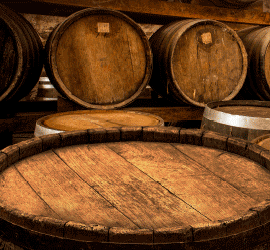World Comparisons
Table 1: Wine production (juices and musts excluded) in major countries4
| Unit: mhl | 2018 | 2019 | 2020 | 2021 | Prov. | 2022 | Prel. 2023 | 23/22 % Var. | 23/avg.18-22 % Var. | 2023 % world |
| France | 49.2 | 42.2 | 46.7 | 37.6 | 46.0 | 48.0 | 4.4% | 8.3% | 20.2% | |
| Italy | 54.8 | 47.5 | 49.1 | 50.2 | 49.8 | 38.3 | -23.2% | -23.9% | 16.1% | |
| Spain | 44.9 | 33.7 | 40.9 | 35.3 | 35.8 | 28.3 | -20.8% | -25.7% | 11.9% | |
| USA | 26.1 | 25.6 | 22.8 | 24.1 | 22.4 | 24.3 | 8.5% | 0.5% | 10.2% | |
| Chile | 12.9 | 11.9 | 10.3 | 13.4 | 12.4 | 11.0 | -11.4% | -9.7% | 4.6% | |
| Australia | 12.7 | 12.0 | 10.9 | 14.8 | 13.1 | 9.6 | -26.2% | -24.1% | 4.1% | |
| South Africa | 9.5 | 9.7 | 10.4 | 10.8 | 10.3 | 9.3 | -10.0% | -8.3% | 3.9% | |
| Argentina | 14.5 | 13.0 | 10.8 | 12.5 | 11.5 | 8.8 | -23.0% | -29.2% | 3.7% | |
| Germany | 10.3 | 8.2 | 8.4 | 8.4 | 8.9 | 8.6 | -3.8% | -2.9% | 3.6% | |
| Portugal | 6.1 | 6.5 | 6.4 | 7.4 | 6.8 | 7.5 | 9.8% | 13.2% | 3.2% | |
| Romania | 5.1 | 3.8 | 3.8 | 4.5 | 3.8 | 4.6 | 21.2% | 9.5% | 1.9% | |
| Russia | 4.3 | 4.6 | 4.4 | 4.3 | 5.0 | 4.5 | -10.0% | -0.6% | 1.9% | |
| New Zealand | 3.0 | 3.0 | 3.3 | 2.7 | 3.8 | 3.6 | -5.8% | 14.3% | 1.5% | |
| Brazil | 3.1 | 2.2 | 2.3 | 2.9 | 3.2 | 3.6 | 12.1% | 31.4% | 1.5% | |
| China | 9.3 | 7.8 | 6.6 | 5.9 | 4.7 | 3.2 | -33.0% | -53.9% | 1.3% | |
| Hungary | 3.6 | 2.4 | 2.6 | 2.6 | 2.5 | 2.4 | -2.1% | -11.2% | 1.0% | |
| Austria | 2.8 | 2.5 | 2.4 | 2.5 | 2.5 | 2.4 | -6.5% | -6.3% | 1.0% | |
| Georgia | 1.9 | 2.1 | 2.1 | 1.9 | 1.9 | 1.9 | -3.0% | -5.8% | 0.8% | |
| Moldova | 1.9 | 1.5 | 0.9 | 1.4 | 1.4 | 1.8 | 27.0% | 25.0% | 0.7% | |
| Greece | 2.2 | 2.4 | 2.2 | 2.4 | 2.1 | 1.4 | -34.4% | -39.7% | 0.6% | |
| Switzerland | 1.1 | 1.0 | 0.8 | 0.6 | 1.0 | 1.0 | 1.8% | 11.6% | 0.4% | |
| Other countries | 15.6 | 14.5 | 14.0 | 13.4 | 13.6 | 13.2 | -2.7% | -6.9% | 5.6% | |
| World total | 294.8 | 257.9 | 262.2 | 259.7 | 262.6 | 237.3 | -9.6% | -11.3% | 100.0% |
Figure in italics: OIV estimates ©OIV
Sources: OIV, FAO, National Statistical Offices, Specialised Press
4 Countries with a wine production equal to or above 1 mhl in 2023.
Table 2: Wine Consumption in Major Countries7
| Unit: mhl | 2018 | 2019 | 2020 | 2021 | Prov. 2022 | Prel. 2023 | 23/22 Var. | 2023 % world |
| USA | 33.7 | 34.3 | 32.9 | 33.1 | 34.3 | 33.3 | -3.0% | 15.1% |
| France | 26.0 | 24.7 | 23.2 | 24.9 | 25.0 | 24.4 | -2.4% | 11.0% |
| Italy | 22.4 | 22.6 | 24.2 | 24.2 | 22.4 | 21.8 | -2.5% | 9.9% |
| Germany | 19.7 | 19.5 | 19.8 | 19.9 | 19.4 | 19.1 | -1.6% | 8.6% |
| UK | 12.9 | 12.6 | 13.7 | 13.9 | 13.1 | 12.8 | -2.9% | 5.8% |
| Spain | 10.7 | 10.2 | 9.2 | 10.3 | 9.6 | 9.8 | 1.7% | 4.4% |
| Russia | 8.6 | 8.7 | 8.5 | 8.1 | 8.4 | 8.6 | 3.0% | 3.9% |
| Argentina | 8.4 | 8.5 | 9.4 | 8.4 | 8.3 | 7.8 | -6.2% | 3.5% |
| China | 17.6 | 15.0 | 12.4 | 10.5 | 9.1 | 6.8 | -24.7% | 3.1% |
| Portugal | 5.1 | 5.4 | 4.4 | 5.3 | 6.1 | 5.5 | -9.2% | 2.5% |
| Australia | 5.3 | 5.8 | 6.0 | 5.6 | 5.4 | 5.4 | -0.1% | 2.4% |
| Canada | 5.1 | 5.2 | 5.3 | 5.3 | 5.1 | 4.8 | -5.6% | 2.2% |
| South Africa | 4.0 | 3.7 | 3.0 | 3.9 | 4.6 | 4.5 | -1.8% | 2.0% |
| Brazil | 3.3 | 3.6 | 4.1 | 4.1 | 3.6 | 4.0 | 11.6% | 1.8% |
| Netherlands | 3.6 | 3.5 | 3.7 | 3.7 | 3.6 | 3.3 | -9.2% | 1.5% |
| Japan | 3.5 | 3.5 | 3.5 | 3.1 | 3.2 | 3.2 | 2.1% | 1.5% |
| Romania | 3.9 | 2.2 | 2.6 | 3.7 | 2.5 | 3.0 | 20.1% | 1.4% |
| Switzerland | 2.4 | 2.6 | 2.5 | 2.6 | 2.4 | 2.3 | -3.0% | 1.0% |
| Austria | 2.4 | 2.3 | 2.3 | 2.4 | 2.4 | 2.3 | -2.1% | 1.0% |
| Czech Republic | 2.0 | 2.2 | 2.1 | 2.2 | 2.2 | 2.2 | -3.7% | 1.0% |
| Other countries | 38.8 | 39.5 | 38.6 | 38.6 | 36.6 | 36.3 | -0.8% | 16.4% |
| World | total | 239 | 236 | 231 | 234 | 227 | 221 | -2.6% |
Figure in italics: OIV estimates ©OIV
Sources: OIV, FAO, National Statistical Offices, Specialised Press
7 Countries with wine consumption equal to or above 2 mhl in 2023.

















